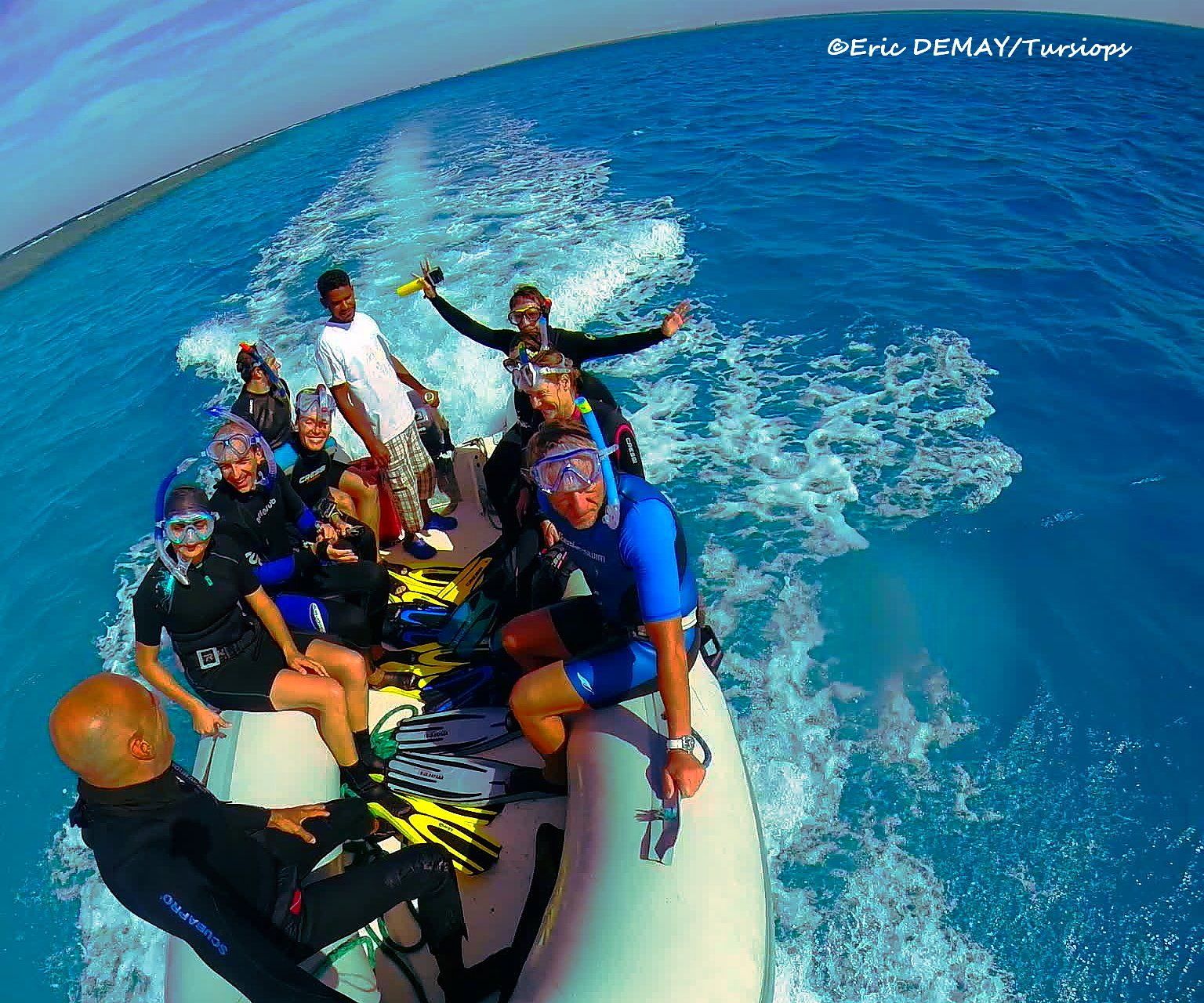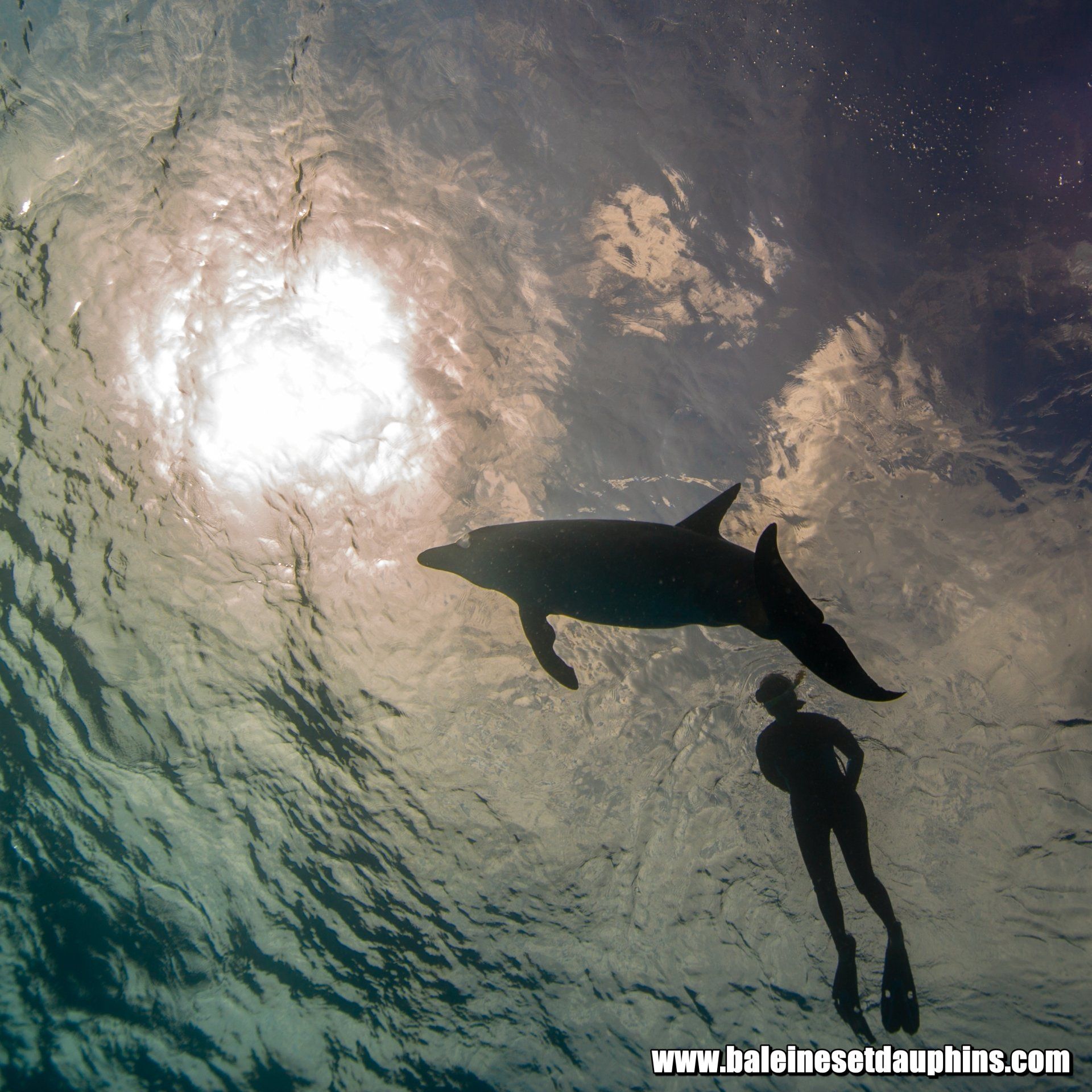Ecovolunteer courses in the Red Sea
Internship progress:
The TURSIOPS association created in 1993 studies the behaviors of dolphins and especially dolphins known as "ambassador" who choose the contact and sometimes the communication with the man.
The last project called "IMMERSION WITH THE DOLPHINS" consists of a follow-up of several
groups of dolphins in the Red Sea particularly active with men.
Scientific surveys are conducted during meetings to participate in the
program of study and protection conducted since 2004 by the Dolphin Watch Alliance.
In addition, video images are systematically produced for the benefit of the association
TURSIOPS in order to accumulate a maximum of data on the man-dolphin encounters.
The association TURSIOPS organizes these missions with the dolphins Tursiops aduncus,
these eco-volunteer placements consist of actively participating in the ongoing study
supervised by Eric DEMAY, specialist of dolphins since 1992.
The TURSIOPS association created in 1993 studies the behaviors of dolphins and especially dolphins known as "ambassador" who choose the contact and sometimes the communication with the man.
The last project called "IMMERSION WITH THE DOLPHINS" consists of a follow-up of several
groups of dolphins in the Red Sea particularly active with men.
Scientific surveys are conducted during meetings to participate in the
program of study and protection conducted since 2004 by the Dolphin Watch Alliance.
In addition, video images are systematically produced for the benefit of the association
TURSIOPS in order to accumulate a maximum of data on the man-dolphin encounters.
The association TURSIOPS organizes these missions with the dolphins Tursiops aduncus,
these eco-volunteer placements consist of actively participating in the ongoing study
supervised by Eric DEMAY, specialist of dolphins since 1992.
By Eric DEMAY, Internship Director:
«We spend the week on a boat specially adapted for swimming in snorkeling (fins, mask
and tuba). We sleep in lagoons well away from the waves, ideal for those who are seasick!
IMPORTANT:
«We spend the week on a boat specially adapted for swimming in snorkeling (fins, mask
and tuba). We sleep in lagoons well away from the waves, ideal for those who are seasick!
IMPORTANT:
For the greatest respect of the animals THE TRAINEES ARE IN THE NUMBER OF MAXIMUM ON a single trip. We sometimes leave with only 6 people.
I do not want "swimming with dolphins" where only profitability matters, cetaceans deserve another approach, the quality of our meetings is our priority.
During a trip we have a 100% chance to meet the dolphins, which to my knowledge represents the place that offers the most opportunities to meet the delphinids.
The dolphins really come to meet us and seek the game, the young of course but sometimes even the adults, a behavior specific to this species, the Aduncus. My idea is to also meet the dolphins in the water by accepting their way of life but however respecting their vital needs, ie sleep and hunting but sometimes also their social interactions. My experience closest to them since 1992 allows me to better guess their needs and their moods. To know an individual is also better to love him and to respect him better. Sometimes they do not want, they can be sick, the night hunt could be a fiasco, a female may be in mourning, I have to take care of that.
I do not want "swimming with dolphins" where only profitability matters, cetaceans deserve another approach, the quality of our meetings is our priority.
During a trip we have a 100% chance to meet the dolphins, which to my knowledge represents the place that offers the most opportunities to meet the delphinids.
The dolphins really come to meet us and seek the game, the young of course but sometimes even the adults, a behavior specific to this species, the Aduncus. My idea is to also meet the dolphins in the water by accepting their way of life but however respecting their vital needs, ie sleep and hunting but sometimes also their social interactions. My experience closest to them since 1992 allows me to better guess their needs and their moods. To know an individual is also better to love him and to respect him better. Sometimes they do not want, they can be sick, the night hunt could be a fiasco, a female may be in mourning, I have to take care of that.
I do not imagine meetings without putting myself at the height of my interlocutor, we must accept to share the daily life in wild animals, we must consider ourselves privileged guests, nothing more. We must adapt our behaviors. Thus, animals feel better considered and real interactions can be created. I have been doing this since my first encounters in Australia and the results are often great. My special relationship with them also helps us a lot in our approach, the experience plays an important role of course, and the feeling with them completes the quality of our meetings.
We have on the boat life jackets for trainees less comfortable in the sea.
The images are shared with local scientists (friends who have the same vision as me in fact, which is unfortunately a little too rare!), You can also with your material participate in this research. We do a lot of photo-identification of the back fins of cetaceans. More than 200 dolphins have been identified and identified but there may be new dolphins or new births, furthermore these photo-identifications need to be regularly updated as they change regularly over time.
First, we try to find the animals and then count them by staying on the boat and fill in the tracking sheets (place, time, weather conditions, numbers of dolphins, GPS ...), then we go to the in order to get a closer look at their behaviors. And of course, we will adapt our behavior to their situation of the next moment if they sleep, move, hunt, interact with each other ... "
The images are shared with local scientists (friends who have the same vision as me in fact, which is unfortunately a little too rare!), You can also with your material participate in this research. We do a lot of photo-identification of the back fins of cetaceans. More than 200 dolphins have been identified and identified but there may be new dolphins or new births, furthermore these photo-identifications need to be regularly updated as they change regularly over time.
First, we try to find the animals and then count them by staying on the boat and fill in the tracking sheets (place, time, weather conditions, numbers of dolphins, GPS ...), then we go to the in order to get a closer look at their behaviors. And of course, we will adapt our behavior to their situation of the next moment if they sleep, move, hunt, interact with each other ... "
The dolphins encountered
"I did not choose to work with these dolphins by chance. I met a lot of these delphinids all over the world and I then needed a lot of favorable conditions for real encounters: easy contact with dolphins, warm water and good visibility under water.
In Australia, conditions have unfortunately changed (swimming with dolphins banned) and visibility is quite average, I think I had the chance to live the "golden years" in Western Australia Bunbury and Monkey Mia ( 1991-1995) but now the local authorities have disrupted considerably this man-Dauphin relationship which offered great opportunities for inter-species communication. Life is life!
The dolphins of the Hurghada region (the ones we are studying) are those of the species Tursiops aduncus which are undoubtedly the dolphins with whom we have strong possibilities to communicate either by play or in another way, less playful but equally remarkable. The Tursiops (at least those I know personally), come to meet us and they are often active with us. However, it is possible that another group may also refuse contact for vital problems (sleep, hunting, education of young people, protection of newborns ...).
Nevertheless, it has already happened that "my intimates" all come to meet me, even in a situation of rest, when I have not seen them for a "long" period.
On my first day with them on the spot of "Dolphin House" a female came to bring me a branch of coral that she had sought at the bottom of the water.
The situation reoccurred during my second stay with another dolphin (the Lino male). Dolphins have already brought shells or corals to my trainees, it's rare but possible!
Already in the Indian Ocean a female Tursiops aduncus had introduced me to her baby just after birth. Another delphine had brought me a fish ... The Tursiops aduncus are really extraordinary, they are in my opinion the most beautiful of the 46 species of delphinids existing (they have big eyes and the old ones become spotted), they are curious, players, very friendly and often surprising! "
Eric Demay, Director of Internships.
In Australia, conditions have unfortunately changed (swimming with dolphins banned) and visibility is quite average, I think I had the chance to live the "golden years" in Western Australia Bunbury and Monkey Mia ( 1991-1995) but now the local authorities have disrupted considerably this man-Dauphin relationship which offered great opportunities for inter-species communication. Life is life!
The dolphins of the Hurghada region (the ones we are studying) are those of the species Tursiops aduncus which are undoubtedly the dolphins with whom we have strong possibilities to communicate either by play or in another way, less playful but equally remarkable. The Tursiops (at least those I know personally), come to meet us and they are often active with us. However, it is possible that another group may also refuse contact for vital problems (sleep, hunting, education of young people, protection of newborns ...).
Nevertheless, it has already happened that "my intimates" all come to meet me, even in a situation of rest, when I have not seen them for a "long" period.
On my first day with them on the spot of "Dolphin House" a female came to bring me a branch of coral that she had sought at the bottom of the water.
The situation reoccurred during my second stay with another dolphin (the Lino male). Dolphins have already brought shells or corals to my trainees, it's rare but possible!
Already in the Indian Ocean a female Tursiops aduncus had introduced me to her baby just after birth. Another delphine had brought me a fish ... The Tursiops aduncus are really extraordinary, they are in my opinion the most beautiful of the 46 species of delphinids existing (they have big eyes and the old ones become spotted), they are curious, players, very friendly and often surprising! "
Eric Demay, Director of Internships.






